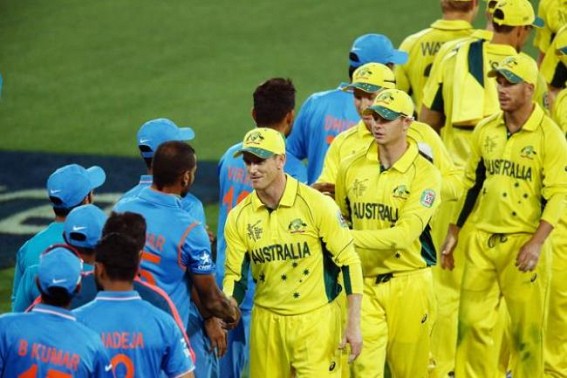Veturi Srivatsa

PHOTO : India Australia world cup semi final match. TIWN /IANS
All the talk of heart and mind on the eve of the India-Australia semifinal was nothing but an expression of the lurking fear that Mahendra Singh Dhoni will, after all, not be returning with the cricket World Cup he had won four years ago.
Dhoni thus lost the opportunity of defending the World Cup and joining Clive Lloyd and Ricky Ponting as the only captains to have done so.
Kapil Dev had the opportunity of retaining the Cup in 1987 but India were literally swept out in the semifinals by England in Mumbai whereas Dhoni won it in his backyard after beating Australia on the way but the roles were reversed this time Down Under.
More than 48 hours have elapsed since the packed Sydney Cricket Ground (SCG), filled mostly by Indians, witnessed a match varyingly described as one-sided, Australia being brilliant and India caving-in without a fight.
Some described Indian batting spineless and some others felt the bowlers let the side down. Sickeningly, there was talk of extraneous considerations for Virat Kohli’s failure with the bat and Dhoni’s thoughtless batting and run-out.
Mercifully, fans have shown a lot of maturity in backing the team after the defeat, unlike some professional mourners in the electronic media. The players have certainly not shamed India as some want us to believe.
How easily the invectives flow after a loss just as the choice of words to praise a victory. For seven matches the wordsmiths went drooling over everything India did and after the eighth, they suddenly seem to have known what was coming.
Deliberate over a few things. The much-maligned Indian bowlers have also brought the side back after an 182-run second-wicket stand between Aaron Finch and Steven Smith, claiming three wickets for 16 runs off 28 deliveries and a fourth for the addition of 23 runs.
Australia had the resources to rebuild the innings and Mitchell Johnson’s nine-ball 27 gave them the psychological impetus to get to a 300-plus score.
Yet, Smith, a Sydneysider, thought the target was par for the SCG and the rollicking start by Shikhar Dhawan and Rohit Sharma gave India more than a sniff of getting a lot closer than they eventually did.
Like Australia, India also lost four wickets for 51 runs, but the difference was not after a big partnership or someone playing a knock of Smith’s substance. If only one of the top four stayed on till the 35th over, things would have been different. At least going by what Dhoni did to give the score a decent look.
If the required target was 143 off 100 or 110 balls instead of 70 and if Ajinkya Rahane stayed with him a little longer instead of becoming the first Indian wicket to fall in the batting powerplay in the entire tournament, Dhoni could have carried on the fight.
At 231/6, he had only Ravichandran Ashwin and the bowlers left with barely six overs remaining. Another five or six overs and even Jadeja with him, Dhoni would have battled it out, though it would not have been easy challenging the two Mitchells -- Johnson and Starc in the death overs.
Though the discussion is academic and futile now, it is only to point out how close India came to making a match of it.
India’s plans came unstuck at crucial stages and a good side seized the opportunities. Australia were clearly the better side, though India would have pleased their fans by coming a lot closer like South Africa did in the first semifinal.
After the match, Dhoni threw up two critical points for cricket administrators to ponder over if the 50-over format has to survive without getting monotonous. It cannot ape Twenty20, tweaking rules to make it high-scoring, killing the bowlers and robbing it of its competitive edge. Scores of over 400 cannot sustain spectator interest.
The field restrictions must be reviewed and steps should be initiated to restore the legitimacy of bowlers, particularly spinners. Even if you keep six fielders guarding the boundaries, the batsmen can clear them or run twos and threes pacing and placing their strokes.
The other point he made is about the use of fast bowlers in domestic cricket. Yes, they need not be bowling in each and every game for their provincial teams and employers. They should be judiciously used. But there are bowlers who would like as many overs as possible to be match-fit, say someone like Zaheer Khan, who spent an entire season in county cricket bowling day in and day out.
If they are not bowling and someone else is on the rampage, it would become a big issue for the selectors. See what happened to Bhuvneshwar Kumar. He was the leader of the attack not long ago but his injury lay-off allowed Mohit Sharma to force his way in with good spells and that was the end of the Uttar Pradesh pacer in the World Cup.
How much load a fast bowler can take is a question that can be answered only by the bowler, bowling coach and physios, not by imposing rigid norms.
(Veturi Srivatsa is a senior journalist. The views are personal. He can be reached at v.srivatsa@ians.in)
- Why Modi’s BJP swept key India regional elections
- TIWN’s landmark legal victory against BJP Govt’s Illegal attacks to shutdown fearless Media
- India to be world's third-largest economy by 2030 -S&P Global Ratings
- Tripura's Dark Era : Mafia style Brutal attacks on Journalists, fight for your Citizen rights !
- How to access tripurainfoway.com via HOLA from India



